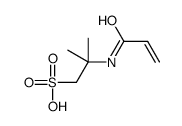Analyzing polyaniline-poly(2-acrylamido-2-methylpropane sulfonic acid) biocompatibility with 3T3 fibroblasts.
Carolyn L Bayer, Isis J Trenchard, Nicholas A Peppas
Index: J. Biomater. Sci. Polym. Ed. 21(5) , 623-34, (2010)
Full Text: HTML
Abstract
Conductive polymers can be utilized as unique functional elements in future intelligent biomaterials required for tissue engineering, cell stimulation and drug delivery. Research in these areas could be limited by established methods of conductive polymer synthesis which do not provide an easy route towards large scale processing of these materials. Typically, conductive polymers are highly insoluble in biocompatible solvents, and can be mechanically brittle, making their integration with biomaterials challenging. As an alternative, the use of a water-soluble conductive polymer for integration with biomaterials, a polyaniline template synthesized with poly(2-acrylamido-2-methylpropanesulfonic acid) (PANI-PAAMPSA), is proposed. To address key fundamental questions about the biocompatibility of this conductive polymer, cell cytotoxicity and proliferation assays have been performed on NIH 3T3 fibroblasts cultured on films of PANI-PAAMPSA. It was determined that the cell cultures maintained growth habits similar to those cultured on the control surfaces. Additionally, conductivity of the PANI-PAAMPSA films subsequent to exposure to the cell culture was demonstrated, indicating the materials retain functionality after cell growth. These results indicate that this type of template synthesized PANI could be successfully implemented as a functional, conductive biomaterial.
Related Compounds
| Structure | Name/CAS No. | Molecular Formula | Articles |
|---|---|---|---|
 |
poly(2-acrylamido-2-methyl-1-propanesulfonic acid)
CAS:27119-07-9 |
C7H13NO4S |
|
PAA-PAMPS copolymers as an efficient tool to control CaCO3 s...
2013-03-05 [Langmuir 29(9) , 3080-8, (2013)] |
|
Dielectric properties of micellar aggregates due to the self...
2011-03-17 [J. Phys. Chem. B 115(10) , 2196-204, (2011)] |
|
Anti-angiogenic activity of heparin-like polysulfonated poly...
2010-11-01 [Biomaterials 31(31) , 7863-72, (2010)] |
|
Hyaluronic acid affects the in vitro induction effects of sy...
2013-01-01 [BMC Musculoskelet. Disord. 14 , 56, (2013)] |
|
Surface sliding friction of negatively charged polyelectroly...
2007-04-15 [Colloids Surf. B Biointerfaces 56(1-2) , 296-302, (2007)] |